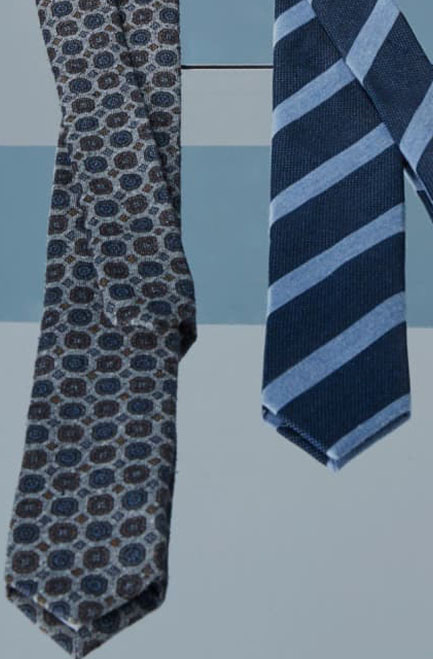Recommend for you
- Catalog
- OUTLET
- NEW
- Big sizes
- SALE last chance

Remote work - what to wear?
A classic suit with a shirt and tie is already a familiar image for us. The tie is associated with business style, formal receptions, and leadership positions. This accessory has hardly changed the last few generations, but it has a rich and interesting history.
For the first time, neck accessories, which can be considered distant ancestors of the tie, are mentioned in the history of several states:
The earliest fact - in 113 BC, the neckerchiefs of Roman legionnaires were depicted in bas-relief in honor of the victory of the ruler Trajan.
Ancient China also demonstrates the image of a modern tie - you can see fabric headbands on the necks of terracotta statues dating back to the reign of Emperor Shixuandi.
In ancient Egypt, the highest ranks wore strips of cloth on their shoulders, which was dictated by government regulations and spoke of high status.

The 17th century can rightly be considered the next milestone in the evolution of the tie. Anna of Austria invited the Croatian officers at the French court, who wished to celebrate their services in the Thirty Years’ War. Her crowned husband, Louis XIV, noticed the officers’ bright silk neckerchiefs. As a fashion legislator, the monarch appreciated the unusual accessory, and soon scarves took their place in the wardrobe of fashionistas of the royal court. It is believed that the word "cravate" (from French - tie) came from the self-name of the Croats. It is also worth noting its consonance with the Ukrainian “kravatka”.
By the end of the 17th century, with the advent of vests, the neckerchief was transformed into a long cloth, resembling a modern scarf. The popularity of this accessory can be judged from the paintings of artists of that time. It was repeatedly wrapped around the neck, and the ends were tied with a decorative knot or left free. There were many options for tying a scarf, almost a hundred. Each method had its own meaning and purpose. According to historians, the harsh fashionistas of that era spent hours in front of a mirror, trying to make the knot refined and elegant.
The tie got its modern name in the 18th century, but its appearance was still far from familiar to us. In revolutionary France, the color of a tie could tell the political views of its owner. Later, in 1827, Honore de Balzac wrote a book on the art of wearing a tie. At that time, ties were sewn from wool, silk, or satin fabric, and their color and pattern were strictly regulated. For example, black was a sign of mourning or a piece of uniform, and white was worn exclusively with a tux or tailcoat for ceremonial events.
At the end of the 19th century, when men began to wear shirts with collars, the long ends of the neckerchief began to be tied with a knot and the free ends were lowered to the chest. In this period, the tie takes its place in the wardrobe of the average person. England also played a significant role in the spread of the tie, with its stubbornness and strict adherence to etiquette. The tie and the way it was tied were a significant part of the costume of a self-respecting gentleman. An unflattering statement about this accessory could be the reason for a duel.
At the same time, Peter I tried to force members of noble families to wear ties, which the nobility actively resisted. But in the Pushkin era, this item of clothing was already popular.


The tie as it is now appeared in 1924, finally displacing the scarves. The authorship is attributed to the American Jamie Langsdorf, who patented the tailoring of a tie from three obliquely cut parts. The pattern of certain colors in the form of stripes, oblique or “cucumber” cells was often used to determine the belonging of its owner to a particular college or club.
At the end of the 20th century, two Cambridge researchers conducted a study on the methods of knitting tie knots. As a result, they found at least 85 ways to tie. However, later Swedish enthusiasts developed a computer program that simulated more than 170 000 ways! However, not all of them can be applied in everyday life, so let’s leave the mind games to scientists. They are often far from reality. There are about 25 most popular and used knots, and if necessary, they can be mastered. However, in reality, few men use more than 1-2 options and the most rational is tying a beautiful knot once, but do not untie it before sending the accessory for cleaning.
Today, a tie is not just a detail of a formal suit. Properly selected, it can attract attention, emphasize the stylish image, and even the color of the wearer’s eyes. A tie can tell about the good taste of its owner, attention to detail, even status - for example if it is an elegant silk tie from Pierre Cardin. There is a wide selection of models and colors of ties in our online store. You can definitely find your “Perfect tie” among them.
And finally, another interesting fact: International Tie Day is celebrated annually on October 18.